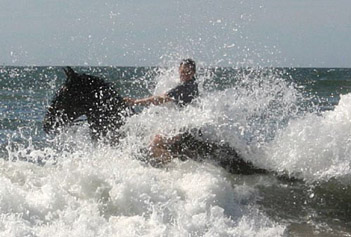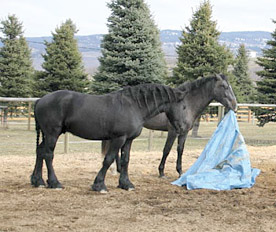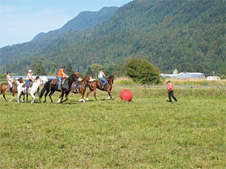Teaching in the Way of the Horse: Training For Courage, Part 2
by Paul Dufresne
In the last Training for Courage article, I discussed how to survive basic courage-building exercises. For many, now would be a good time to move to the more proactive and effective ways of developing the emotional fortitude in a horse. Advance and retreat coupled with strong, confident leadership will have a very positive effect on the horse's acceptance of what might have been very worrisome situations. With many horses this is not enough to make things safe, so how can you take training for courage further ?
To be more successful at this we have to start understanding herd dynamics and use them to our advantage. In a herd there is always a lead horse, and others follow in a hierarchy. It is natural for horses to challenge for the lead, especially if success might obtain a higher degree of comfort for them.
We need to have already done the work to make sure our horse understands yielding to our various pressures and will go, with respect and compliance, in any direction we so choose. Once a horse does this, we can take the next step by putting ourselves in front of the horse, between him and any scary situation we want him to accept. As previously discussed, this is a must for survival with the natural emotional instability and explosiveness of the horse in testing uncomfortable or new situations. By being in front of the horse, lets say approaching whatever scary obstacle we've selected, we calmly approach it without staring at our horse. We are the lead horse; if we act like there is nothing to be worried about, they will tend to consider trying to be braver themselves.

If we couple this with a bit of the advance-retreat method from the previous Training for Courage article, we can develop the courage in the horse much more quickly. If a horse is truly terrified but it tries to go with us, we can give it a very small treat, tell it "good!" and walk away.
Here is where things get interesting, and some horses who would take forever to gain some courage go into a real accelerated acceptance program...
I would become the fearless leader with my pony in tow. Now, instead of just approaching the frightful object on a long lead, I would move toward--let’s say in this instance a bag of tin cans--and kick it out in front of me. I would keep kicking it forward, away from the horse, in a totally relaxed manner. The body language of the leader is critical, as it cannot lie. The horse will see right through it if your relaxation isn't genuine. It is not hard to be courageous in this situation because if the object is in front of you, the horse will not charge over you to get to it. It may want to retreat, but you can move side-to-side, always approaching the bag of tin cans.
Now, as you near the bag, the horse will have that head-up "oh-oh" look. When you kick it away, the horse’s head will go into flight mode; then, as the bag careens away from you, the horse will stand there looking a bit bewildered at times, realizing the bag has been moved away from him. By repeating this multiple times, soon the chicken on the string often comes and hides right behind you, thinking you're pretty cool and much braver than he is.
If we use this type of approach with most objects that we can move away, the same positive attitude in the horse will start to develop in our lead. Horses will not generalize their courage to include different obstacles--this is why I am not fond of the desensitization or the "get used to it" approaches. What the horses can take with them is their brave leader who says, "Nothing will hurt you when you are following me." So don’t let them down, or they will lose trust in you.
What also happens in this process is that many horses will actually want to come and investigate after the leader has beaten up the scary thing, especially if we bend over in a small, relaxed position, investigating it ourselves. Again, here I would not recommend letting the horse touch the object—I would build up the desire to touch it much higher first. The higher I build the horse’s desire to investigate for himself, the less likely he will fear it when he does come in contact.
At clinics or in small groups you can progress with this even further. Let’s say we had a big herd of twenty horses and twenty leaders all in the same training setting. Now the bravest leader and follower would approach a specific obstacle and move it away from them.

This is where we double and triple and so on by having the next bravest leader and follower take over with other pairs following behind this beating of the obstacle away from the herd. Think about it. If a horse starts to think, "Wow, I can follow my owner-leader to the scariest place and he is never scared and doesn’t let these things hurt me…" then they start to see all of these other human leaders doing the same thing, there is a very calming effect because the courage rubs off on everyone. When done correctly, it could be very hard to find a chicken on a string in the whole herd.
This establishes us as a braver individual than the horse. How many of you readers wouldn’t follow someone if you really didn’t have a better choice than to do so, and they never got you hurt and stayed calm no matter how ugly it first looked? Again, this attitude toward your lead can be taken to all new and scary situations, cutting the time to accept things in half or more. I have seen a multitude of owners gain confidence in their lead when they realize they can do it safely and control their own body language to feel calm. If you are not sitting on a keg of dynamite, you usually feel better about things. If you are anxious, you will send mixed messages and the horse will know you are worried. Relaxed shoulders, posture, and breathing are good, while looking downward nonchalantly will get you big dividends.
Lastly, the most effective way of all to have a horse be courageous is to set up the horse to release its topline and release at the poll. The tightness or locking at the poll is directly connected to the flight emotions and to the feel-good reflex of the horse. A horse with a tight poll locks up with the head ready for flight. It's hard to stop a horse in this state. On the other hand, if we set up the horse to release the poll under our control, and then make it a taught cue, we can cause the horse to dangle loosely when we ask (see the article, “Bending and Releasing the Poll”). In the dangle position it is extremely difficult to get a horse scared. This is similar to a natural reflex in humans. Think of something that made you very sad or upset, then have a friend tell you a really funny joke or just smile--see if you can hang on to that bad feeling.

This is why it is so important to keep smiling. If we are feeling good, we don’t have time to feel bad. With horses, if we have the feel good on a cue and can travel on a horse with a released and relaxed poll, where the head dangles on a plumb, and approach any and all situations like nothing bad will ever happen, the horse will buy it willingly. Ask your horse to be brave because you have shown him there is no reason to feel otherwise, and remember to enjoy the educational journey!